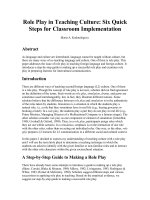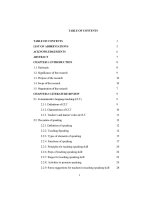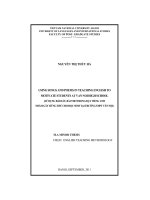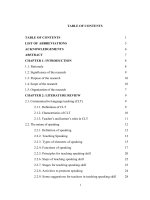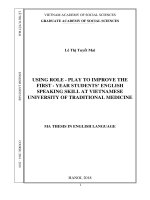Using role play in teaching english for nonmajor students
Bạn đang xem bản rút gọn của tài liệu. Xem và tải ngay bản đầy đủ của tài liệu tại đây (154.34 KB, 13 trang )
USING ROLE PLAY TO IMPROVE FIRST YEAR NON ENGLISH MAJOR STUDENTS
‘S SPEAKING COMPETENCY IN TERMS OF FLUENCY IN T&M EDUCATION
CENTER
1
As reviewed in the previous work, role play can be seen as one of the successful strategies to
help students enhance their speaking competency (Nunan (1991), Ladousse (1987) and Livingstone
(1983)). In the aspect of improving student’s speaking fluency, role play seems to stimulate students
to speak with motivation, confidence, body language and meaning transference. In the context of T
& M Education Center, role play is not familiar with students and rarely applied in many speaking
lessons. Students there often practice speaking based on text books’ activities and teachers’ guides.
Repeated activities together with boring and tiring speaking lessons prevent my students from
speaking with their enjoyment and motivation. Moreover, my students, like other Vietnamese
students, usually confront with a lot of difficulties in speaking abilities. They may lack of
vocabulary to speak or they are too shy. They have little time to speak in the class; hence, their
interaction is slow. One more important obstacle is that they feel ashamed when making mistakes so
they try to hide themselves and say as little as possible to avoid their errors. Realizing these matters
in my class, I am conducting a study to know whether role play can help to develop their speaking
skill in terms of fluency. Two research questions were raised to find a better teaching method to
improve the situation: ‘Can role play help to improve students’ English speaking competency in
terms of fluency?’ and ‘What are students’ attitudes toward role play activity in a speaking
lesson?.
To collect the data for the research, a variety of books and journals have been reviewed
carefully to find out proper methods. Therefore, this study’s purpose is to review on some main
research methods and to examine the appropriate ones to be applied in this work. The application of
these research methods will be discussed in details later.
To present the reasons for choosing some particular methods, an overview of research methods
will be looked through quickly to ensure that all choices are clarified meaningfully and suitably. A
numerous works have discussed and supplied fundamental and important theories on research
methods as can be seen in Brown (1988), Creswell (2003), Hinchey (2008). There is hardly any
significant difference in the ways these works defining and classifying research methods. Most
researchers agree that there are two major kinds of research methods: quantitative method and
qualitative method. On the contrary, Brown (1988) depicted a broader view of research
methodology and he divided it into two types; primary research and secondary research due to the
sources of information that the researchers want to collect. He then subdivided primary research
into case studies and statistical studies, secondary research into survey and experimental studies.
2
His work in 1988 only focused on statistical researches and he motivated teachers to use these
methods when showing clearly what should be done in each step during the process of a statistical
research. Brown probably used a different term for quantitative research there. In fact, statistical
research shares the same value with quantitative ones. It is likely that with the emergence of
qualitative researches in the twentieth century, his views are no longer the hottest and the most
attractive ones. Moreover, a great demand from teachers who consider themselves as researchers
requires a strong development of qualitative researches which focus on human’s perceptions, not
statistical evidences. Recently, a mixed- method research which combines quantitative and
qualitative method is often listed as the third type of research method as in works of Creswell
(2003) and Muijs (2010). It is believed that this combination will increase the validity and reliability
of the research.
According to Creswell (2003), a quantitative research is ‘one in which the investigator primarily
uses positivist claims for developing knowledge’, whereas a qualitative research is ‘one in which
the inquirer often makes knowledge claims based primarily on constructivist perspectives’ (p. 18).
In order to address the terms of positivist and constructivist, a clear explanation can be found in
Hinchey’s work (2008). She initially states the definition with an interesting saying: ‘‘It is not a
black or white issue’’ (p. 19). These words beautifully captured the description of two research
paradigms, positivist and interpretivist or constructivist. They originated from the true value of
knowledge that the true is out there in the world or the true depends on each one’s perception. For
positivist research paradigm, she discusses that the behaviors of human can be discovered
universally like natural sciences through conducting trial experiments. Therefore, the truth is stable,
fixed and unchanged in any conditions. The role of researchers here is out of the truth, in other
words, they are objective in the way they discover the findings. On the contrary, interpretivist
research paradigm seeks the truth in particular settings and conditions. The researchers are involved
in the process of observing and analyzing the truth. Therefore, in Hinchey ‘s ideas, the knowledge
may vary because of different ways of seeing it and it depends on a number of factors such as
culture, interests, personal experience and so on. She showed precisely that “interpretivist can be
useful to others when they offer new insights into related situations” (p. 24). That means
interpretivist approach can explore the truth from different angles with more critical thinking.
Hinchey (2008) presented the two paradigms as a foundation for further explanation of
quantitative and qualitative research method. She explained that “quantitative research is used
3
interchangeably with positivist research” (p. 27). They might be different in some cases; however,
they were similar in depending on statistical analysis. That means qualitative falls on interpretivist
paradigm which bases on the analysis of behaviors. Apart from Hinchey, there are many works
focusing on the difference between quantitative research and qualitative research. Most researchers
discovered the difference from his/her perceptions so that their ideas are correlated and
supplemental to one another. Muijs (2010) distinguished two methods in a clear and easy-tounderstand analysis. He pointed out four main types of research questions which belong to
quantitative research. These questions require the numerical methods to answer such as “How
many”. Especially, he highlighted that “quantitative research is good at providing information in
breadth, from a large number of units, but when we want to explore a problem or concept in depth,
quantitative methods can be too swallow” (p. 7). From his point of views, qualitative research can
supply a deeper analysis and in the process of gathering data, unexpected outcomes may appear.
In the work focusing on qualitative methods by Family Health International et al (2005), a more
detail comparison between the two types was well presented. They showed that the most important
difference was their flexibility. In qualitative methods, data were collected considerably through
asking open-ended questions. As a result, the responds for these questions were flexible and
changeable. These questions enable participants to express their own ideas freely, not in a fixed
response format as in quantitative methods. It seems that in some cases, qualitative methods are
more useful and effective than quantitative ones. However, the matter of effectiveness depends on
what the researcher wants to find out and which paradigms he/she chooses to follow in the first
stage of doing researches. “You can never empirically or logically determine the best approach. This
can only be done reflectively by considering a situation to be studied or your own opinion of life”.
(Arbnor & Bjerke, 1997, p.5, cited in Blaxer, Hughes & Tight, 2010, p. 58).
Basing on these above differences of the two research approaches, this study will be located in
interpretivist paradigms and qualitative methodologies will be used to collect the data for finding
the answers for two research questions. It is important to restate that this research‘s aim is to
explore student’s attitudes towards role play application in a speaking lesson. As a result, the
research’s objects cannot be in numerical forms for analyzing and they require in-depth analyses.
The sample size is also small; hence, only qualitative methods are suitable to find the outcomes for
this study. After considering many research methods, this study will use semi-structured interview,
observation and narrative inquiry as its tools to collect data. The combination of three research
4
methods is essential to ensure the validity and reliability of the outcomes. As stated in Chapter 2 in a
series of edition by Dahlberg and McCaig (2010), this combination can be called triangulation
methods which enable this study to achieve better and reliable results. Hinchey also supports this
idea by showing that triangulation application can avoid ambiguity and improve confidence in the
findings.
First of all, semi-structured interview can be regarded as one of the most common qualitative
methods (Smith & Bowers-Brown, edited by Dahlberg & McCaig, 2010). A very simple definition
of semi- structured interview can be found in Hinchey’s work (2008). “Semi-structured interview is
an interview in which the researcher asks some predetermined questions but also allows
interviewees times and opportunity to explore other areas they think relevant” (p. 82). Three kinds
of interviews were discussed in Hinchey’s views as structured- interview, semi-structured and unstructured interview. Most researchers agree with this classification as Patton (2002), DiCiccoBloom & Crabtree (2006). They also stress that the crucial advantage of semi-structured interview
is its flexibility by using open-ended questions. That enables interviewees to express their feelings
freely. Additionally, it creates a warmer and comfortable atmosphere to increase the trustworthiness
between interviewers and interviewees. For some authors as Turner (2010), interviews, in general,
help to explore the truth deeply through a variety of participants’ stories based on their own
experiences, beliefs, and viewpoints. This advantage was significantly acknowledged by Marshall &
Rossman (1989) as “The process takes in a wider variety of information than if there were fewer
participants- the familiar trade-off between breadth and depth. Immediate follow-up and
clarification are possible”(p.102). However, they realized some main disadvantages of interview.
The data collected from interview can be difficult to analyze because of its complexity. There are
many factors affecting to the interview process such as the relationship and trustworthiness of
interviewers and interviewees, the topics, the interviewees’ characteristics , for example, they are
excited to talk or they are shy, preserved and do not want to share so much and so on. Semistructured interviews seem to possess all these strengths and weaknesses as a general interview. But
it is different from other types of interviews. It is less structured than structured interview, so it is
more flexible. The interviewees are free to talk and the interviewers can probe intermediate
questions following interviewees ’responses. In addition, it is easier to be analyzed than
unstructured interviews because it has a list of guided questions for participants to follow.
5
An example of using semi- structured interview is a study of Lupton (1988). She wanted to
know about food preferences of participants. Then she conducted thirty three semi-conducted
interviews which were carried out by four female interviewers of whom she was included. Lupon
used many open-ended questions to ask participants about their food preferences. For example, she
wanted to know which kinds of food people liked or disliked; which types were considered to be
healthy or unhealthy; which types were seen as a good way to lose weight or gain weight; were
there any changes in food preferences when they grow up. In the process of an interview, many new
questions were asked to satisfy the purpose of the study. In the study of Pham (2006), a semistructured interview was carried out in seven English educators in Vietnam. He wanted to look for
the reason why teachers seem to neglect doing research in their institutions. He emailed to 21
English teachers all around the country to invite them to participate in the interview. There are only
seven teachers to whom he could access to have a face- to- face interview. Before the interview, a
set of predetermined questions in open-ended forms was delivered to them so as to guide them
through the content before the real talks. The native language for both the researcher and the
participants, Vietnamese, was used in the interview. After that these talks were transcribed and
translated into English. There were two participants to check for the accuracy of the transcripts. The
interviews helped to reveal one of some main reasons for his research questions. He found out that
Vietnamese teachers did not want to do research because they did not have enough time available.
One more reason was that they felt discouraged because there is no hope for their research findings
to be disseminated. In Pham’s study, interviews are used practically to seek the findings for his
questions. It can be inferred from the above strengths that interview is a useful tool to collect the
data for my research.
The second method will be reviewed and taken a great consideration is observation. Observation
is defined as a process of watching and participating in a natural setting to study about people‘s
activities in this environment (Kawulick, 2005). Marshall & Rossman (1989) previously took
observation as “a fundamental and highly important method in all qualitative inquiry” (p. 99). It is
clearly demonstrated that to catch all the moments in a speaking lesson, observation seems to be
very effective to describe students’ performance and attitudes. According to Schmuck (1997) (cited
in Kawulich, 2005, p.2), this method “provide researchers with ways to check for nonverbal
expression of feelings, determine who interacts with whom, grasp how participants communicate
with each other’’. This idea is of significant importance for this study because it aims to examine
6
students’ performance in terms of fluency in a speaking lesson. That means observation can easily
check whether students interact with one another; whether they use their body language to
communicate successfully; and whether they can transfer the meaning of the conversation with their
high motivation and excitement.
According to Van Lier‘s classification (1988), observation methods are divided into two kinds:
participant observation and non-participant observation. Later they were called convert and open
observation as in Smith & Bowers-Brown (2010).Van Lier showed that the most commonly used in
classroom research was non- participant observation. That meant the observer did not participate
into the classroom lesson. They sat from afar like birdwatchers. They focused on what they wanted
to find out and took notes with careful attention. In his views, this method has some main
advantages. It is easy to carry out in any classroom conditions. Its results can be used to analyze and
evaluate teacher’s teaching ability, methods and techniques. It can also evaluate students’ attitudes,
levels and learning styles in some cases. However, there are some problems when applying this
method. As in his book, Van Lier (1988) emphasized that “an observer may never be able to observe
a natural, undisturbed lesson” (p.39). There is a tendency that when teachers and students realize the
occurence of unfamiliar observer in the class, they will behave in different ways. They may try to
hide their mistakes and conduct the lesson with their best efforts. Especially it is likely true in
teaching and learning contexts in Vietnam where people seem to consider losing face as an
unacceptable experience. Everything will be well prepared and as I remember when I was a student,
teacher designed special questions and gave students beforehand. They would then act like a perfect
machine which had been programmed in advance. Consequently, the results might not reflect real
situations of any classrooms. Moreover, this method required experienced observers who had to be
expertise in the evaluation process. They strictly followed the principle and ethics of classroom
observation. One more thing was that their opinions and evaluation were totally subjective. Van Lier
significantly stated that it was quite difficult to keep a truly objective observation because
unintended factors from personal perspectives might appear. These factors could result in unreliable
findings and solutions. In short, a clear view for both strengths and weakness of observation should
be taken into account carefully before applying it in this study. Taking an example of Dixon’s study
in 2013, he discovered the disconnection between teachers and young learners in a Grade 2 class
(Students from 7 to 8 years old). He watched the teaching practice from the back of the classroom
and realized that the teacher had no connection with her students, even ones who were in trouble
7
and wanted a help from the teacher. Dixon claimed that young students were expected to be cared
for their interests and needs. Teachers, hence, would know how to engage each child in the lesson
and how to see teaching process through students’ eyes. By analyzing the photos taken during the
lesson, combining with all field notes from his observations, he concluded that in the context of
South Africa, students had no place for themselves to participate in classroom’s activities.
Moreover, old practices in education prevented teachers from connecting with their students. They
were considered as the most powerful and dominant in the class. In his study, observation proves to
be a very suitable and effective tool to collect the information.
The third method will be presented in this study is narrative inquiry. To begin with the definition
of narrative inquiry, it is very interesting to quote a thoughtful saying from Butler-Kisber (2010)
which was adapted from a North American perspective. As in his saying, narratives were used to
“bring silenced voices to centre stage” (p. 63). It is considered as one of the most important feature
of narrative inquiry in terms of exploring people’s thoughts, beliefs, and their hidden or unheard
stories. Most researchers agree with the definition that narrative inquiry is a qualitative method
which uses participants’ stories to gather the data. Chase (2005) explained that a narrative story tell
important things or bring a close relation about life from its inception. Before the time of Chase,
Richardson (1995) highlighted the value of using narrative as “If we wish to understand the deepest
and most universal of human experience, if we wish our work to be faithful to the lived experiences
of people,…then we should value the narrative” (pp.218-219). Bell (2002) also had a very
interesting way of seeing narrative when saying that “they provide a window into people’s beliefs
and experiences” (p. 209). These authors share a true value of one of the most significant strengths
of narrative. It is its ability to convey people’s living authenticity underneath their stories. Bell
developed his idea in 1997 which clearly showed some main advantages of narrative as: providing a
deep analysis on people’s experience; opening new assumption to the surface and illuminating the
temporal motion of experience (p.209). However, he realized some weaknesses of narrative
application. In his view, narrative is hard to apply for a large number of samples because of time
consuming. Additionally, the collaboration between researchers and participants played an
important role in the success of a narrative process. Especially, he stressed the most serious problem
was the ethics of story tellers.
Barkhuizen (2008) discovered that narrative inquiry was so powerful in helping him to integrate
into Afrikanans- speaking teachers’ lives. They came from South Africa and were living in New
8
Zealand then. He wanted to unveil the experiences of being immigrants in a new country. Two
teachers who were named Betty and Roxanne told him about their early living experience there.
After that they shared and analyzed these stories as a part of the course assessment. He suggested
that this way of using narrative could be very useful for other teachers under the same
circumstances. Particularly, these teachers, after reflecting their own problems, could themselves
chase their own solutions. Cadman and Brown (2011) used narrative to investigate living conditions
of English teachers in remote Aboriginal Australia, where the new policy was implemented to
improve English competency for students. Through the stories of three teachers, they saw, what they
called, ‘shocking moments’ of their lives the first time they taught there. In this context, they found
out that “narrative inquiry became a convincing and salient methodology for our research” and “saw
the potential to flesh our teachers’ lived experience” (p. 446). These two mentioned studies are
worth considering for choosing an appropriate method for this study.
After looking carefully through three research methods, I will use them to collect the data for
checking my hypothesis. In T & M Center, a course includes 24 lessons, equal to 48 learning hours.
There are 24 students in my class, 9 males and 15 females. I plan to apply role play activities in four
weeks (equal to 12 lessons because they have three lessons per week). Due to limited time and it is
a private center, so it is not easy to ask for permission from the Director for a longer time to pilot a
new method. After four weeks of role play implementation, I will spend time to conduct an
interview with my students. I choose those who are volunteers to participate in my research. I intend
to interview no more than ten students, so in case there are more than ten volunteers, I will choose
ten out of them randomly. The semi-structured interview will focus on some main questions:
1. What do you think about role play?
2. How do you feel when taking part in a role play activity?
3. How does role play motivate you to speak?
4. What do you like/ dislike about role play?
These questions will be designed in open- ended forms to let students talk as much as they can. As
reviewed in the first stage, a semi- structured interview is flexible and easy to extend to other
questions, which enables students to feel comfortable and relaxed as if they were in a daily talk with
their teacher (Hinchey, 2008). Therefore, there will be more than four basic questions to ask and
these questions will arise when these interviews happen. It takes about 30 minutes for each
interview section. Then I will record these interviews; transcribe them after finishing 10 interviews.
9
The data will be coded and analyzed depending on different themes. At that time I will know
students’ feelings, attitudes towards role play activities.
If interview is conducted after four weeks of role play application, then observation will be
conducted during the four weeks. Three volunteer teachers who are teaching at T & M will be the
observers in six lessons. Time limitation prevents me from asking them to observe for more than six
lessons. When they observe, they will take notes and pay attention to some main points of the
speaking practice. Four criteria of a successful speaking ability in terms of fluency will be the
yardstick for their notes. They are the way students using their body language, meaning
transference, the way they speak with enjoyment and motivation and whether they are confident or
not when they speak to their friends. I will collect these notes and analyze to find out how my
students perform in four weeks.
Three volunteer teachers, after giving me their notes, will continue to write narratives to reveal
what role play can bring to them on the perspectives of teachers. These stories will help me to
discover their thoughts, beliefs, and experience on teaching role play in a speaking lesson. I will
give them a limitation for a story of 500 to 800 words to shape their writing length in order to avoid
the waste of time and effort.
Before conducting this study, I realize some problems in ethics that often happen in a qualitative
research. According to the theory of Smith (2010) (edited by Dahlberg & McCaig), I will strictly
follow his guidelines for acknowledging these arising problems. First of all, before I conduct my
research, I have to inform to all participants the detailed information of the study. The informed
consents will be given for all participants and it is essential to give them all related information that
they want to know. I will make the plan as explicit as possible and clearly demonstrate what I want
to find out, what I expect to get after the study. This helps to provide participants a clear view of
what will happen in the process of doing the research as well as the time schedule. Participants must
be ones who are volunteers to take part in the program. They have the right to withdraw at any time
they need, and to refuse to be involved in any researches. In case they are on the half way of the
program and for some reasons, they do not want to continue, it is necessary to get their permission
for the usage of their data in the study.
Besides, when conducting interviews with students, I will ask for their permission for recoding
in tapes of their voices. If they do not like, I will switch off the tape before starting the conversation.
All the information collected from them will be kept secretly and only used for my research’s
10
purposes. I also have to ask for permission from the Director of T & M Center, and then ask the
voluntary and collaboration of my colleagues.
To sum up, this study will bring a new approach to teaching methods for both teachers and
learners in EFL context. They will have a clearer and more detailed view about role play and its
application in a speaking lesson. Moreover, it helps to guide students to a successful communication
which can be achieved not only through the ability to use a language, but through other supporting
factors such as body movement, meaning transference and motivation. It can create a new further
step for doing another research in case role play is proved not to be a proper choice in this context.
(Words count: 4,265 words)
11
References
Barkhuizen, G. ( 2008). A Narrative Approach to Exploring Context in Language Teaching. ELT
Journal, 62 (3), 231-239.
Bell, J. S. (2002). Narrative Inquiry: More than just Telling Stories. TESOL Quarterly, 36, 207212.
Blaxter, L., Hughes, C., & Tight, M. (2010). How to research. Maidenhead: Open University
Press. McGraw-Hill Education.
Brown, J. D. (1988). Understanding research in second language learning: A teacher's guide to
statistics and research design. Cambridge. Cambridge University Press.
Butler-Kisber, L. (2010). Qualitative inquiry: Thematic, narrative and arts-informed
perspectives. Los Angeles: Sage
Cadman, K., & Brown, J. (2011). TESOL and TESD in Remote Aboriginal Australia: The "True"
Story? TESOL Quarterly, 45(3), 440-462.
Creswell, J. W. (2003). Research design: Qualitative, quantitative, and mixed method
approaches. Thousand Oaks, Calif: Sage.
DiCicco‐Bloom, B., & Crabtree, B. F. (2006). The qualitative research interview.Medical
education, 40(4), 314-321.
Dixon, K. (2013). A Change of Perspective: Seeing through Children at the Front of the
Classroom, to Seeing Children from the Back of the Classroom. Studies in Philosophy
and Education, 32 (3), 273-284.
Family Health International., Mack, N., Woodsong, C., & United States. (2005).Qualitative
research methods: A data collector's field guide. North Carolina: FLI.
Hinchey, P. H. (2008). Action research primer. New York: Peter Lang.
Kawulich, Barbara B. (2005). Participant Observation as a Data Collection Method. Qualitative
Social Research. 6 (2), retrieved from />12
Marshall, C., & Rossman, G. B. (1989). Designing qualitative research. Newbury Park, Calif:
Sage.
Moen, T. (2006). Reflections on the narrative research approach. International Journal of
Qualitative
Methodology,
5(4),
Article
5.
Retrieved
from
/>Muijs, D. (2010). Doing quantitative research in education with SPSS: Sage.
Pham, H, H. (2006). Researching the Research Culture in English Language Education in
Vietnam. TESL Journal. 10 (2). 2-19.
Smith, M. & Bowers-Brown, T. Different Kinds of Qualitative Data Collection Methods.(2010).
In Dahlberg, L.& McCaig, C (Eds.). Practical research and evaluation: A start-to-finish
guide for practitioners. 111-125. London: Sage.
Smith, M. (2010). Ethics and Research Governance. In Dahlberg, L.& McCaig, C
(Eds.). Practical research and evaluation: A start-to-finish guide for practitioners. 111125. London: Sage.
Turner, D.W., III (2010). Qualitative interview design: A practical guide for novice investigators.
The
Qualitative
Report,
15(3).754-760.
Retrieved
from
/>Van, L. L. (1988). The Classroom and the Language Learner: Ethnography and second
Language classroom research. London: Longman
13
